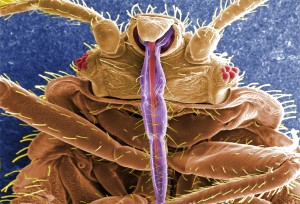Bed bugs are very tiny creatures that are scientifically named Cimex lectularius. Are you really curious about how bed bugs look like?
Your chances of getting face to face with bed bugs is really slim. You can only see them by looking at their pictures, which are published in text books, magazines and Internet sites.
Pictures of bed bugs that you can actually see in available sources are somehow enlarged. Because bed bugs are so small, you can never really look at their physical structure even if you hold them unto your palm.
You may need to use a magnifying glass or several lenses just to take a rather unclear glimpse of bed bugs.
Description from pictures
You may not wish to look at bed bugs face to face, or eye to eye. In a recent unpublished research in the US, it was discovered that most people are scared to look at any or all insects.
You might be one of them. So to save you the embarrassment and awkward feeling, it is safe that you just take a look at pictures of bed bugs from available sources.
By simply looking at bed bugs’ pictures, you can see that bed bugs are normally flatted when viewed from top to bottom. It is this physical attribute that enable them to penetrate to the most tiny holes or crevices around.
Pictures of bed bugs also reveal that the insect takes several colors. Majority of bed bugs appear deep brown. But there are those which also look white or creamy white. You may think, so bed bugs also have races, huh?
Look at pictures of bed bugs before and after they have consumed blood from their respective victims. Then compare. Take note that bed bugs change color after they have been fully nourished.
Almost all bed bugs appear deep red or somehow almost black after they have consumed blood.
That is because the blood they suck makes up most of their body. Crashing bed bugs during these states of their lives is certainly disgusting. Imagine squashing out fresh blood from a balloon.
Somehow scientific view
Pictures of bed bugs in text books and encyclopedias also will give us a glimpse of their anatomy.
Looking at such pictures, you will see that the bed bug has a very complex skin type that is usually covered by wax-like substance. This wax-like substance make up or give protection to the bed bug.
That structure will protect or prevent bed bugs from drying out or from getting wet. Because bed bugs are so tiny and their internal system is not that developed, without the protective structure, direct exposure to air and light will surely dry out or dehydrate them.
Looking at these pictures will also aid in understanding how pesticides and insecticides work.
Usually, pesticides and insecticides come in the form of sprays. Embarked in these sprays are very tiny and powderized form of silica and glass. These two materials are hard and will certainly cut through any hard object in which they are forced to.
Powderized glass and silica will have to go with the spray. After the bed bugs are exposed to such spray, their protective structure or layers will then be destroyed or ruined. Powderized glass and silica can do that.
Imagine bed bugs’ anatomical and physical structure – look at the pictures more closely. After the protective layer is destroyed, that’s the time when the chemical components of the sprays get to work.
When the protective layers of the bed bugs is finally destroyed, harmful chemicals will get inside the skin and attack the internal system of the bed bug.
Chemicals present in spray normally act out to dehydrate or dry out insects like bed bugs.
Large bed bugs
But did you know that you have another option or an alternative way if you want to take a close look at bed bugs
Because most bed bugs in your room are very tiny, and pictures in textbooks can look and seem unrealistic, you can opt to capture an old, aging and mature bed bug.
Usually, such bed bugs are more than a year old. These bed bugs are almost always dying or at the final stage of their cycle because bed bugs’ life span only last more than a year at most.
Very old bed bugs usually can grow about one fourth of an inch.
Looking face to face with bed bugs can never be a worthwhile and fun experience. Just don’t look at bed bugs’ pictures if you don’t want those goose bumps or you do not want another throw-up session.
Filed under: Bed Bugs
